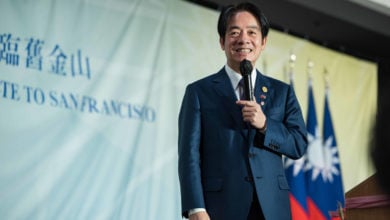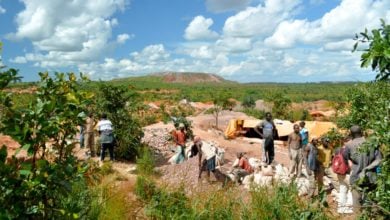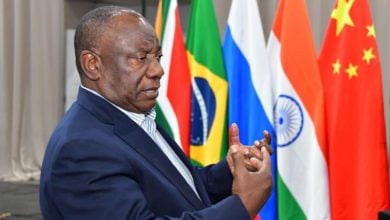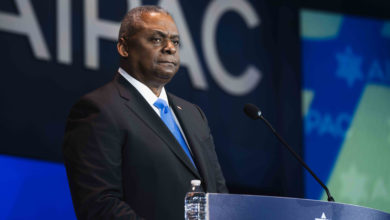It all started simply enough two weeks ago when the police chief and mayor in Washington, D.C., unveiled a major new “crime-fighting” focus on “synthetic drugs.” The full implications became clear with a front-page Washington Post article on June 22 with the title “Deadly Chinese drugs are flooding the U.S., and the police can’t stop them.”
This hysteria around synthetic drugs from China has been latched onto by two powerful set of opportunists: one being the police and supporters of mass incarceration seeking to reboot the war on drugs; two, the security establishment. They both seek to justify the massive military power being assembled to contain China.
This is the perfect example of the synergy between wars abroad and at home and the corresponding connection between this and the government apparatus that sits at the nexus of both repressive apparatuses.
What is happening?
The principal issue at stake is the increase in the use of certain types of synthetic drug, which go by many names and take a variety of forms, from synthetic marijuana to crystalline substances like methamphetamines. The constantly shifting list of chemicals in the substances at issue means that they exist in a semi-legal gray area and can sometimes be sold openly in stores.
Some of the substances like PVP have been banned by states and the federal government in an attempt to crack down.
The very framing of the issue, however, is problematic. Rather than deal with demand, it focuses on supply. China is accused of allowing its, of course, “loosely regulated” chemical industry to pump out these harmful drugs in ways that are hard to detect but massively lucrative. The real issue though is the mass market for drugs, principally in the United States. According to a 2013 study, roughly 10 percent percent of the U.S. population regularly uses illicit drugs. On the top four illegal drugs alone, people in the U.S. spend roughly $100 billion a year.
People in the U.S. also consume 75 percent of the world’s prescription drugs, which of course can also be ripe for abuse and addiction. It really is no secret that the U.S. appetite for mood-altering substances stands at the heart of the global drug trade.
The National Institute on Drug Abuse, which essentially supports the war on drugs, notes people take drugs to both “feel good” (that is “have novel feelings, sensations, experience and share them”) as well as to “feel better,” meaning to “lessen anxiety, worries, fears, depression” and “hopelessness.”
In other words, the social reality of U.S. capitalism is both the most dull to the human senses and devastating to human emotions of any in the world, this the world’s largest market for drugs as well as a powerfully commentary on our culture.
Why prohibition
The new focus being taken by the Metropolitan Police Department in the District of Columbia has one they claim to be going after “suppliers” and not “addicts.” By suppliers, it seems what the police in our nation’s capital really mean are the stores selling in a semi-legal way these synthetic drugs, sometimes openly. This has included everything from the creation of a new unit to a major increase in the penalities for selling synthetic drugs.
D.C. cops and politicians are presenting their proposal as if it is partially in response to the Black Lives Matter movement. DCFerguson, an activist group in D.C., has subjected the police to withering criticism over their attachment to racist militarized policing. Police have claimed, without saying it outright, that many of the abusive and brutal policies of harassment employed by the police will end.
What is in fact happening is more subtle. On the one hand, police are appearing to assuage complaints about their behavior, while on the other they are re-justifying the war on drugs. The new policy is at its core the same as the old policy. It relies on an aggressive police presence to enforce ever harshening anti-drug laws.
However, the war on drugs, mass incarceration and militarized policing have been exposed as more about social control then crime fighting. As The Economist noted, in 2013 mass incarceration policies were clearly becoming “increasingly counterproductive.” The new strategy then is an attempt to maintain the core of these policies while making changes around the edges. For instance, the new policy by the cops in D.C. will drive the market further underground, and in a more violent direction, which of course reinforces the militarization of the police. Further, the “new” threat of these “more potent than ever” drugs justifies the intense drive against them.
This was the same script used with heroin, crack and meth. The government identifies a new drug whose illegality creates a violent black market and that supposedly is the worst public health threat since Ebola.
So while on the one hand, attitudes towards substances like marijuana are relaxed, new boogeymen are constantly created and illegalized to act as the underpinning to the mass-incarceration-militarized-policing-complex.
‘Pivot to China’
As we noted in a previous article:
“China’s ambitions—as many honest bourgeois commentators have pointed out—are mainly regional and that they have no desire to become the replacement of the United States.
“If this is the case, it does not square with the U.S. attempts to isolate China and overthrow the Chinese Communist Party. The United States is shifting the vast majority of its military force to Asia to contain China. Pentagon publications often refer to the need to “stay ahead” of China in military technology. The U.S. has encouraged the return of the warlike section of the Japanese ruling class as well as constructing a major trade agreement entirely designed to pressure China to accept the Western “rules of the game” in global economic flows.
“China-hawks like Senator Chuck Schumer (D-Wall Street) have attempted to target the Chinese economy through currency “manipulation” amendments to various bills. America bucked even its closest ally—the United Kingdom—in an attempt to sabotage the Chinese-initiated development bank. The White House and U.S. press have portrayed the building of an airstrip on a tiny Chinese island as the most aggressive move in world history since Hitler seized the Sudetenland.
“Why? Simple: The U.S. refuses to give up its global imperial hegemon status and fears that China’s rise will promote a multi-polar world. So, they must be contained at worst and changed into a vassal at best.
“However, to justify this to the populace, China must appear to pose an existential threat.”
As we also noted in the earlier article, the playing up of China as a cyber-threat clearly fits this bill, as does the synthetic drug story. It promotes a narrative of an evil China made up of cyber-terrorists and chemical companies pumping drugs into your kids bodies that turn them into zombies. This is the literal rhetoric. Again, though, this accusation misses the mark. How the problem is China when clearly the issue is drug abuse makes clear the hidden agenda at work by the law-enforcement and state department officials steadily blaming China.
.
Who Benefits?
In both cases then, hysteria doesn’t do anything to solve the problem. From a policing standpoint, it simply replicates the clearly failed war on drugs. From the “national security” standpoint, it misdiagnoses the source of the problem to blame China for an issue rooted in American social reality. The end result is a continuation of mass incarceration and militarized policing as well as the world-wide military efforts made by the U.S. to enforce imperial rule around the world.
Both moves come at critical junctures. The militarized model of policing is under siege as is mass incarceration, and the American people are as wary of being entangled in wars abroad as ever before. Thus, as the security forces of the American state and the assumptions behind them are being challenged powerfully, unsurprisingly these powerful forces are fighting back and seeking to redirect the conversation.
There really are not separate “domestic” and “foreign policy” spheres. The national government decision makers deal with both sets of issues that intertwine with each other and the interests of their various donors in complex ways.
The forces of “law and order” at home and abroad are at the center of power in U.S. capitalism, and the challenges mounted to them are serious. We must see through their lies and evasions to plot a course that uproots the militarism and racism at the core of American military might in the South China Sea or the streets of Southside Chicago.






